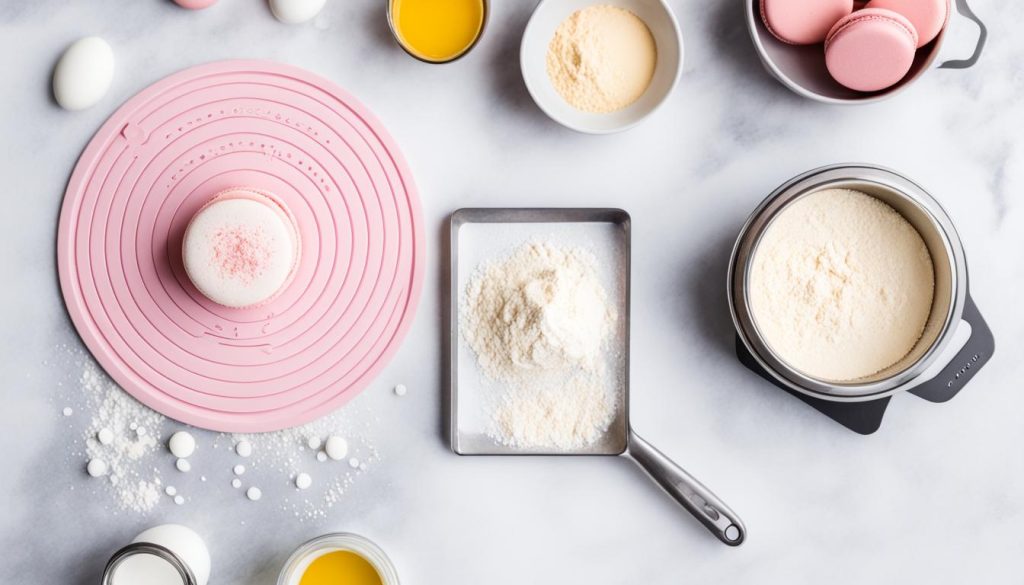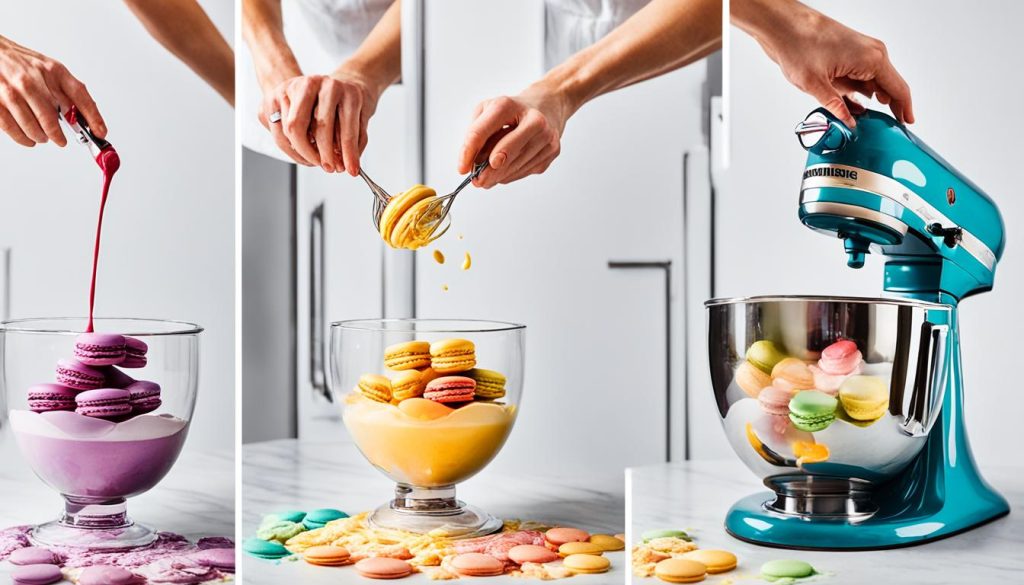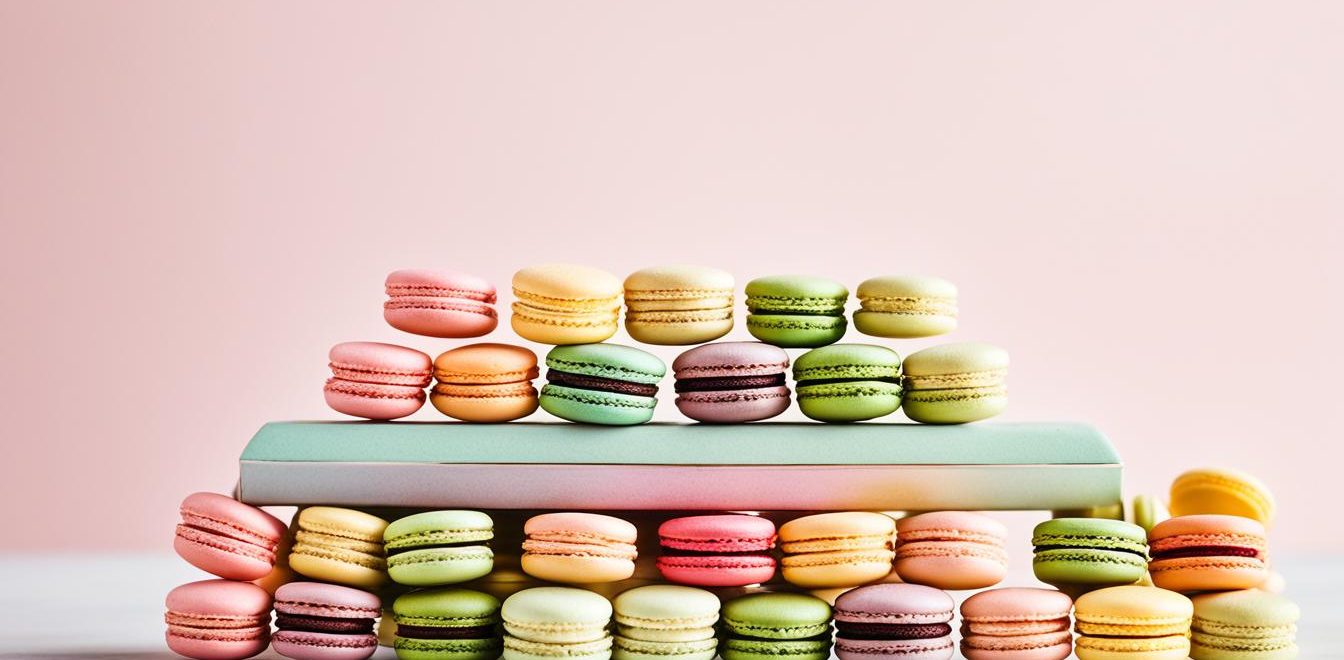Table of Contents
Have you ever wondered how to create those beautiful, delicate French macarons that always seem to impress? Do you find yourself craving the sweet, chewy goodness of these almond-based treats and want to learn how to make them yourself? Look no further! This ultimate guide will take you on a journey into the world of macaron baking, providing you with all the tips, tricks, and recipes you need to become a master macaron maker.
From mastering the perfect macaron shell and exploring a world of delicious flavors to troubleshooting common issues and achieving that elusive “feet” on your macarons, we’ve got you covered. Whether you’re a complete novice or have dabbled in macaron baking before, this guide is designed for beginners who want to take their baking skills to the next level.
So, are you ready to embark on a macaron baking adventure? Let’s get started!
The History and Basics of French Macarons
French macarons are delicate sandwich cookies with a crisp exterior and a chewy texture. These delightful treats have become popular all over the world, known for their beautiful colors and irresistible flavors.
To understand the artistry of macaron baking, it’s important to grasp the basics. At its core, a macaron consists of two almond meringue shells, or macaron shells, sandwiched together with a luscious filling. One bite reveals a harmonious blend of textures and flavors that makes these cookies truly special.
The macaron shells are the foundation of these delightful treats. Unlike other baked goods, macarons don’t rely on chemical leaveners to rise. Instead, their lift comes from properly beaten egg whites. This technique, known as the French meringue method, creates a light and airy shell with a crisp surface.
The ingredients for macarons are relatively simple but require precision. The basic components include egg whites, cream of tartar, superfine sugar, fine almond flour, and confectioners’ sugar. These ingredients, when combined in just the right proportions, create a batter that transforms into elegant macaron shells.
Once the macaron shells are baked to perfection, it’s time to fill them. Traditional fillings for French macarons include buttercream, ganache, or other sweet fillings. This filling, or macaron filling, adds another layer of flavor and texture to the cookies, creating a truly indulgent experience.
The art of French macarons stretches back centuries, with a rich history that continues to captivate bakers and pastry enthusiasts around the world. By understanding the history and basic components of French macarons, you’ll be well-equipped to embark on your own macaron baking journey and create beautiful, delicious treats. So, let’s dive into the world of macarons and unlock the secrets to mastering these delectable cookies.
Essential Tools and Ingredients for Macaron Baking
To achieve macaron baking success, it is important to have the right tools and ingredients. Here are some essential tools and ingredients you’ll need for your macaron baking journey:
1. Macaron Tools
- Glass or Metal Bowls: Avoid using plastic bowls as they can retain grease and affect the stability of the egg whites.
- Egg Separator: To separate the yolks from the whites easily and achieve a perfect meringue.
- Food Scale: For accurate measurements of ingredients, especially the almond flour and powdered sugar.
- Electric Mixer: To whip the egg whites to stiff peaks efficiently. A stand mixer or a hand mixer works well.
- Fine Mesh Sieve: Essential for sifting the dry ingredients and removing any lumps, ensuring a smooth batter.
- Piping Tip & Bag: To shape the macaron batter into perfect rounds. A medium-sized round tip works best.
- Baking Sheet & Liner: Use a good quality baking sheet and a silicone baking liner or parchment paper for even baking and easy removal of the macaron shells.
Having these tools on hand will make the macaron baking process much smoother and help you achieve consistent results.

Preparing the Macaron Batter
Preparing the macaron batter involves several important steps. Let’s walk through them to ensure your macarons turn out perfect!
- Start by aging the egg whites in the refrigerator for at least 24 hours prior to starting the recipe. This improves their elasticity during the whipping process, resulting in better macarons.
- Next, add cream of tartar to the egg whites. This ingredient helps in stabilizing the meringue, giving your macarons a light and airy texture.
- To provide structure to the macaron shells, add superfine sugar. Its fine texture ensures that the sugar dissolves properly in the batter.
- For the dry ingredients, use a combination of fine almond flour and confectioners’ sugar. These ingredients create a sturdy batter, giving the macarons their characteristic chewy texture.
- If desired, you can add a pop of color to your macarons by using gel food coloring. This is purely optional but can make your macarons visually appealing.
Now that you know the key ingredients and steps for preparing the macaron batter, you’re ready to move on to the next stage of the baking process.
The Science of Macarons: Meringue and Macaronage
The science behind macarons is a fascinating combination of meringue and the art of macaronage. Understanding these two crucial elements will help you create the perfect macarons every time.
French Meringue
The most common type of meringue used in macarons is French meringue. It is created by beating egg whites and gradually adding superfine sugar until stiff peaks form. The resulting meringue is light, airy, and delicate, providing the perfect structure for the macaron shells.
Italian Meringue
If you prefer a more reliable meringue, Italian meringue is an excellent choice. This meringue is made by pouring a hot sugar syrup into egg whites while beating them. The hot sugar syrup cooks the egg whites, resulting in a stable and silky meringue. Italian meringue is known for its reliability and is often used in professional bakeries.
Swiss Meringue
Another type of meringue that can be used for macarons is Swiss meringue. It is made by whisking egg whites and sugar together over a double boiler until the sugar dissolves. This meringue is then whipped to stiff peaks. Swiss meringue is slightly denser than French meringue and creates macarons with a slightly different texture.
Whichever meringue method you choose, the key is to achieve stiff peaks to ensure a stable macaron batter.
Macaronage: The Art of Folding
Macaronage is the term used to describe the process of folding the dry ingredients into the meringue. This step is essential in achieving the desired texture and structure of the macaron batter. It requires a delicate balance between undermixing and overmixing.
Undermixing the batter can result in lumps and an uneven texture, while overmixing can lead to flat and spread-out macarons. It’s important to fold the dry ingredients into the meringue just until the batter is smooth and flows like lava, ensuring a perfect macaron shell.
To achieve the ideal macaronage consistency, gently fold the dry ingredients into the meringue using a spatula. Make slow, deliberate movements, scraping the sides and bottom of the bowl to incorporate all the ingredients evenly. Be careful not to overmix and deflate the meringue during this process.
Remember, practice makes perfect when it comes to macaronage. With time and experience, you’ll develop a feel for the ideal texture and achieve consistently beautiful macarons.

Piping and Baking the Macarons
Now that you have prepared the macaron batter, it’s time to move on to the next crucial steps: piping the batter and baking the macaron shells. These steps play a significant role in achieving perfectly shaped macarons with the desired texture. Let’s take a closer look at each of these steps:
Piping the Batter
Piping the macaron batter onto a baking sheet is an art that requires precision and practice. Using a piping bag fitted with a round tip, gently squeeze the batter onto the baking sheet in small circles, about 1 inch in diameter. Keep the circles evenly spaced to ensure uniformity in size. This technique helps create well-formed macaron shells.
Getting Rid of Air Pockets
After piping the batter, it’s essential to get rid of any air pockets that may have formed during the piping process. Lift the baking sheet a few inches above the counter and drop it firmly to remove any trapped air. Repeat this process a few times to ensure a smooth batter and to prevent hollow or cracked shells.
Baking the Macaron Shells
Baking the macaron shells is the final step in the process. Preheat your oven to the recommended temperature specified in your recipe. Place the filled baking sheet in the center rack of the oven and bake for the prescribed amount of time. The shells should have a lightly crisp exterior and a tender, chewy interior.
Remember, oven temperatures and baking times may vary, so it’s important to closely monitor the macaron shells throughout the baking process. Keep an eye out for the cues of doneness – a slightly golden color and a delicate, smooth texture.
By piping the batter onto the baking sheet, removing air pockets, and baking the shells to perfection, you’ll be able to create beautiful and delicious macarons that are sure to impress.
Filling and Flavoring Macarons
Once the macaron shells are baked and cooled, it’s time to fill and flavor them. This is where you can get creative and add your personal touch to these delightful treats!
There are various methods for filling macarons, so you can choose the one that suits your preference. One popular method is piping buttercream onto the macaron shells. Buttercream is a smooth and creamy filling that complements the crisp exterior and chewy texture of the macarons.
Ganache is another delicious option for filling macarons. Made from a combination of chocolate and cream, ganache adds richness and depth of flavor to the macarons. You can experiment with different types of chocolate, such as dark, milk, or white chocolate, to create unique variations.
If you’re feeling adventurous, you can try other fillings like fruit jams, caramel, or even flavored cream cheeses. These fillings add an extra burst of flavor and make each bite a delightful surprise.
Now let’s talk about flavoring your macarons. The possibilities are endless! You can keep it classic with flavors like vanilla, chocolate, or coffee. Or you can get creative and add fruit extracts such as strawberry, raspberry, or lemon for a refreshing twist.
If you have a sweet tooth, consider adding extracts like almond, coconut, or hazelnut to infuse your macarons with a hint of nutty flavor. You can also experiment with spices like cinnamon, cardamom, or lavender to add a unique and aromatic touch to your macarons.
Remember, when flavoring your macarons, a little goes a long way. Start with a small amount, taste the filling, and adjust as needed to achieve the perfect balance of flavors.
To inspire you, here are some tasty macaron flavor ideas:
- Luscious Lemon: Fill your macarons with tangy lemon curd for a burst of citrusy goodness.
- Decadent Chocolate Mint: Add a drop of peppermint extract to your chocolate ganache for a refreshing twist.
- Strawberry Cheesecake: Pipe a creamy strawberry cheesecake filling for the ultimate indulgence.
- Matcha Madness: Infuse your macarons with earthy matcha tea powder for a unique and vibrant flavor.
- Salted Caramel Delight: Drizzle salted caramel sauce onto your macaron shells for a sweet and salty combination.
Get creative with your flavors and fillings, and don’t be afraid to experiment. Macarons are a versatile canvas for your culinary imagination. Enjoy the process of filling and flavoring your macarons, and let your taste buds be your guide!
Troubleshooting Macaron Issues
Macaron baking can be challenging, and there are common issues that may arise. Understanding these issues and their potential causes will help you overcome challenges and improve your macaron baking skills. Here are some troubleshooting tips for common macaron problems:
Egg Whites Won’t Peak in the Meringue
If your egg whites are not reaching stiff peaks when making the meringue, try using fresh eggs at room temperature. Make sure there are no traces of yolk in the whites, and use a clean, grease-free bowl and whisk. Adding a pinch of cream of tartar can also help stabilize the meringue.
Shells Are Cracked
If your macaron shells are cracking during baking, it could be due to overmixing the batter or insufficient resting time. Ensure that you mix the batter just until it reaches the right consistency and let the piped shells sit at room temperature to form a dry skin before baking.
Shells Are Hollow
Hollow macaron shells can be caused by undermixing the batter or underbaking the shells. Be sure to fold the dry ingredients into the meringue until you achieve a smooth and flowing batter. Additionally, adjust the baking time and temperature to ensure proper cooking throughout.
Shells Are Too Brown
If your macaron shells are turning too brown during baking, it may be due to oven temperature fluctuation or placing the baking sheet too close to the heat source. Use an oven thermometer to ensure the correct temperature and adjust the rack position if needed.
Shells Are Difficult to Remove or Stick to Sheet Pan
If your macaron shells are sticking to the sheet pan or are difficult to remove, it could be because they are underbaked or your baking sheet is not properly lined. Ensure that you use parchment paper or a silicone mat to line the baking sheet, and bake the shells until they are set and easily lift off.
Shells Didn’t Develop Feet
If your macaron shells did not develop the characteristic “feet,” it could be due to undermixing, overmixing, or improper resting time. Aim for the right consistency during macaronage, ensuring that the batter flows smoothly and holds its shape. Allow the piped shells sufficient time to rest and form a skin before baking.
Shells Are Misshapen
If your macaron shells turn out misshapen, it could be because of uneven piping or an uneven oven temperature. Use a piping template or guide to maintain consistent shape and size. Additionally, check that your oven is evenly heated by using an oven thermometer.
By addressing these common macaron issues, you can troubleshoot and improve your macaron baking skills. Remember, practice makes perfect, and with persistence and a little experimentation, you’ll be creating beautiful and delicious macarons in no time.
Tips for Perfect Macarons
Achieving perfect macarons requires precision, patience, and practice. Follow these tips to elevate your macaron baking skills and create beautiful and delicious treats:
- Precision in Measurements and Techniques: Accurate measurements are crucial for consistent results. Use a kitchen scale to weigh your ingredients precisely. When folding the dry ingredients into the meringue, be gentle and deliberate to achieve the right consistency.
- Practice and Experimentation: Macaron baking is a skill that improves with practice. Don’t be discouraged by initial failures; learn from them and keep experimenting. Each batch is an opportunity to refine your technique and discover new flavors.
- Finding the Right Oven Temperature and Timing: Macarons are sensitive to temperature, so it’s important to understand your oven’s quirks. Experiment with different temperatures and baking times to achieve the desired texture and color. Keeping a log of your baking times and oven temperature can help you find the perfect balance.
- Using High-Quality Ingredients: Macarons shine when made with top-notch ingredients. Invest in quality almond flour, superfine sugar, and pure extracts for the best flavor and texture. Don’t forget to use fresh, high-quality egg whites to ensure a stable meringue.
By incorporating precision, patience, and practice, you’ll be well on your way to mastering the art of macaron baking. Remember, it’s a journey of experimentation and improvement, so don’t be afraid to embrace the process and have fun along the way!
Conclusion
Congratulations on completing the ultimate guide to macaron baking for beginners! We hope this comprehensive guide has provided you with the knowledge and confidence to embark on your French macaron baking journey. Remember to practice, experiment, and have fun with different flavors and fillings.
With precision, patience, and practice, you’ll be able to create perfect French macarons every time. Follow the baking tips provided throughout this guide, and don’t be discouraged by any challenges you may encounter. Macaron baking is an art that requires practice, but the results are well worth it.
Now that you have a solid understanding of the ingredients, techniques, and troubleshooting methods, it’s time to put your newfound knowledge to the test. Grab your tools, gather your ingredients, and get ready to create delicious and stunning macarons that will impress your friends and family. Happy baking!

